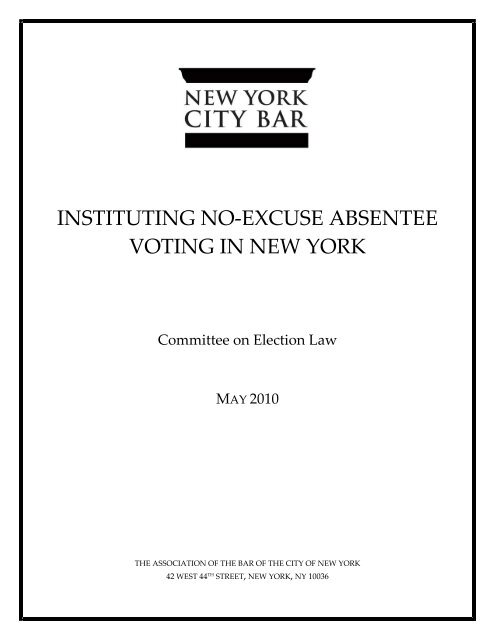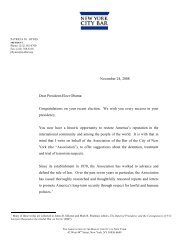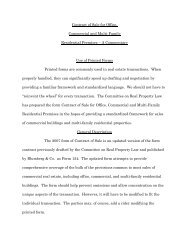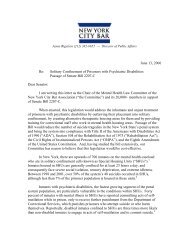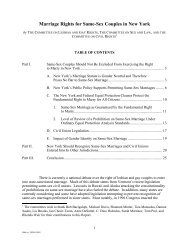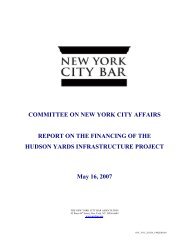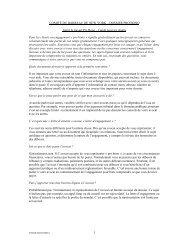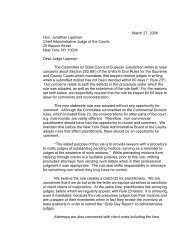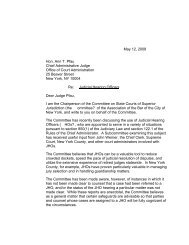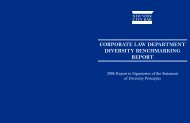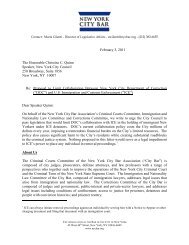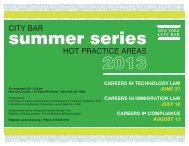Instituting No-Excuse Absentee Voting in New York (May 2010)
Instituting No-Excuse Absentee Voting in New York (May 2010)
Instituting No-Excuse Absentee Voting in New York (May 2010)
You also want an ePaper? Increase the reach of your titles
YUMPU automatically turns print PDFs into web optimized ePapers that Google loves.
INSTITUTING NO‐EXCUSE ABSENTEE<br />
VOTING IN NEW YORK<br />
Committee on Election Law<br />
MAY <strong>2010</strong><br />
THE ASSOCIATION OF THE BAR OF THE CITY OF NEW YORK<br />
42 WEST 44 TH STREET, NEW YORK, NY 10036
Higher voter turnout <strong>in</strong> <strong>New</strong> <strong>York</strong> <strong>in</strong> the 2008 Presidential Election has renewed<br />
the debate regard<strong>in</strong>g how to improve <strong>New</strong> <strong>York</strong>’s electoral process. Many other states<br />
nationwide have <strong>in</strong>stituted election reforms such as no-excuse absentee vot<strong>in</strong>g, Election<br />
Day registration, and early vot<strong>in</strong>g as a means to ease voters’ access to the polls, and<br />
hopefully <strong>in</strong>crease voter participation. This report addresses no-excuse absentee vot<strong>in</strong>g,<br />
the reform that has already been enacted by nearly thirty states, which simply removes<br />
from the Election Law any requirement that a voter provide an excuse before be<strong>in</strong>g<br />
issued an absentee ballot. Enactment of no-excuse absentee vot<strong>in</strong>g <strong>in</strong> <strong>New</strong> <strong>York</strong> would<br />
allow <strong>New</strong> <strong>York</strong> registered voters who f<strong>in</strong>d themselves unable to appear at their local poll<br />
site on Election Day, regardless of the reason for their absence, to vote <strong>in</strong> advance of the<br />
election us<strong>in</strong>g an absentee ballot. 1<br />
After review<strong>in</strong>g this issue, the Election Law Committee recommends that the<br />
legislature pass an amendment to the <strong>New</strong> <strong>York</strong> State Constitution to allow for no-excuse<br />
absentee vot<strong>in</strong>g and, upon successful constitutional amendment, enact legislation<br />
implement<strong>in</strong>g no-excuse absentee vot<strong>in</strong>g <strong>in</strong> <strong>New</strong> <strong>York</strong>.<br />
1. Current <strong>New</strong> <strong>York</strong> Law on <strong>Absentee</strong> <strong>Vot<strong>in</strong>g</strong><br />
<strong>New</strong> <strong>York</strong> law currently requires voters request<strong>in</strong>g an absentee ballot to provide<br />
an excuse for their <strong>in</strong>ability to vote at their designated poll<strong>in</strong>g place. The only acceptable<br />
excuses are: unavoidable absence from the county of residence (or from all of <strong>New</strong> <strong>York</strong><br />
City for City voters) due to duties, occupation, bus<strong>in</strong>ess, or studies, or accompany<strong>in</strong>g a<br />
1 <strong>No</strong>-excuse absentee vot<strong>in</strong>g is dist<strong>in</strong>guishable from early vot<strong>in</strong>g <strong>in</strong> that registered voters who have been<br />
issued absentee ballots (after complet<strong>in</strong>g an absentee ballot application, reviewed by the Board of<br />
Elections) may cast such absentee ballots by mail. Early vot<strong>in</strong>g, by contrast, <strong>in</strong>volves cast<strong>in</strong>g a vote <strong>in</strong><br />
person prior to Election Day, typically on a vot<strong>in</strong>g mach<strong>in</strong>e at a centralized poll<strong>in</strong>g location. This report<br />
addresses no-excuse absentee vot<strong>in</strong>g only.<br />
1
spouse, parent, or child for that person’s unavoidable absence; absence due to vacation;<br />
<strong>in</strong>ability to vote due to illness or physical disability; status as an <strong>in</strong>mate or patient at a<br />
veteran’s adm<strong>in</strong>istration hospital; and status as an <strong>in</strong>mate prior to conviction or postconviction<br />
for a crime other than a felony. Election Law § 8-400. Voters must state their<br />
excuse on their absentee ballot application, and swear to the truthfulness of the stated<br />
excuse. Id. Any voter with an excuse to vote absentee other than one of the enumerated<br />
excuses, such as child care, unavoidable duties with<strong>in</strong> the county or <strong>New</strong> <strong>York</strong> City, or<br />
extreme <strong>in</strong>convenience, is not entitled to an absentee ballot under current <strong>New</strong> <strong>York</strong> law.<br />
2. <strong>New</strong> <strong>York</strong> Constitutional Provision on <strong>Absentee</strong> <strong>Vot<strong>in</strong>g</strong><br />
A threshold question <strong>in</strong> the analysis of whether the state legislature should adopt<br />
no-excuse absentee vot<strong>in</strong>g is whether it may do so consistent with the <strong>New</strong> <strong>York</strong> State<br />
Constitution. If the legislature does have the power to provide for no-excuse absentee<br />
vot<strong>in</strong>g, it may do so by ord<strong>in</strong>ary legislative enactment—passage by the Assembly and<br />
Senate, followed by approval by the Governor. But if a constitutional amendment is<br />
necessary, then the road to such a reform is much longer. A constitutional amendment<br />
must be passed by both the Assembly and Senate <strong>in</strong> two consecutive legislative sessions,<br />
followed by approval by the voters via a referendum. Then, depend<strong>in</strong>g on whether the<br />
amendment itself provides for no-excuse absentee vot<strong>in</strong>g or merely empowers the<br />
legislature to provide for it, the legislature may still need to enact legislation provid<strong>in</strong>g<br />
for no-excuse absentee and secure the Governor’s signature.<br />
Article II, Section 2 of the <strong>New</strong> <strong>York</strong> Constitution provides:<br />
The legislature may, by general law, provide a manner <strong>in</strong> which, and the<br />
time and place at which, qualified voters who, on the occurrence of any<br />
election, may be absent from the county of their residence or, if residents<br />
of the city of <strong>New</strong> <strong>York</strong>, from the city, and qualified voters who, on the<br />
- 2 -
occurrence of any election, may be unable to appear personally at the<br />
poll<strong>in</strong>g place because of illness or physical disability, may vote and for the<br />
return and canvass of their votes.<br />
In lay terms, this provision empowers the state legislature, at its option, to provide for<br />
absentee vot<strong>in</strong>g to those who are either (1) absent from their home county (or from <strong>New</strong><br />
<strong>York</strong> City for city residents) on Election Day, or (2) physically unable to vote <strong>in</strong> person.<br />
This provision neither expressly allows nor expressly prohibits any form of absentee<br />
vot<strong>in</strong>g other than these two enumerated reasons.<br />
Thus the Constitution is silent on whether the legislature may provide for absentee<br />
vot<strong>in</strong>g by voters that are neither absent nor physically unable to vote <strong>in</strong> person, i.e. voters<br />
that do not have an “excuse” for vot<strong>in</strong>g absentee. 2<br />
In addition, it appears that this is a<br />
case of first impression <strong>in</strong> that no court has specifically considered whether the<br />
legislature may provide for absentee vot<strong>in</strong>g <strong>in</strong> a manner other than these two enumerated<br />
reasons. In order to predict whether a court would strike down a no-excuse absentee<br />
statute as contrary to Article II, Section 2 of the Constitution, it is necessary to <strong>in</strong>terpret<br />
that provision as a court might do.<br />
When <strong>in</strong>terpret<strong>in</strong>g the specific mean<strong>in</strong>g of a specific provision of the State’s<br />
Constitution, <strong>New</strong> <strong>York</strong> courts apply the same general pr<strong>in</strong>ciples that govern the<br />
construction and <strong>in</strong>terpretation of statutes. Wendell v. Lav<strong>in</strong>, 158 N.E. 42, 44 (N.Y.<br />
1927). These pr<strong>in</strong>ciples of statutory construction adopt the maxim expressio unius est<br />
exclusio alterius, which means that “where a law expressly describes a particular act,<br />
th<strong>in</strong>g or person to which it shall apply, an irrefutable <strong>in</strong>ference must be drawn that what<br />
is omitted or not <strong>in</strong>cluded was <strong>in</strong>tended to be omitted or excluded.” See McK<strong>in</strong>ney’s<br />
2 As discussed later <strong>in</strong> this report, many voters believe they do have an excuse for absentee vot<strong>in</strong>g, even if<br />
it is not a constitutionally or statutorily contemplated excuse, such as work<strong>in</strong>g long hours or multiple jobs,<br />
child care, etc.<br />
- 3 -
Statutes (1971) § 240. In the specific context of legislative silence, <strong>New</strong> <strong>York</strong>’s statutory<br />
construction rules provide that “when from the language of an act . . . it appears that the<br />
Legislature has specified the cases to which it shall apply, the failure to specify a<br />
particular case <strong>in</strong>dicates that the Legislature did not <strong>in</strong>tend the act to cover such case.”<br />
Id. § 74.<br />
Apply<strong>in</strong>g these rules, it appears that the <strong>New</strong> <strong>York</strong> State legislature may not,<br />
consistent with Article II, Section 2 of the <strong>New</strong> <strong>York</strong> Constitution, provide for no-excuse<br />
absentee vot<strong>in</strong>g. The language of this constitutional provision <strong>in</strong>dicates that its framers<br />
specified the two categories of qualified absentee voters: those absent from their county<br />
on Election Day, and those physically unable to appear at the polls. Hav<strong>in</strong>g provided<br />
those two specific cases to which absentee vot<strong>in</strong>g shall apply, the failure to provide for<br />
absentee vot<strong>in</strong>g for other voters <strong>in</strong>dicates that the framers did not <strong>in</strong>tend the provision to<br />
cover such voters.<br />
As a result, the Committee f<strong>in</strong>ds that a legislature <strong>in</strong>cl<strong>in</strong>ed to enact no-excuse<br />
absentee vot<strong>in</strong>g would be required to amend the Constitution <strong>in</strong> order to do so.<br />
Accord<strong>in</strong>gly, appended to this report is a simple proposed amendment, which removes<br />
restrictions on non-Election Day vot<strong>in</strong>g to provide to the legislature the flexibility to craft<br />
legislation to make vot<strong>in</strong>g more convenient. Such an amendment would permit the<br />
legislature to provide for no-excuse absentee vot<strong>in</strong>g, early vot<strong>in</strong>g, or any other measure<br />
<strong>in</strong>volv<strong>in</strong>g vot<strong>in</strong>g on a day other than Election Day.<br />
3. <strong>No</strong>-<strong>Excuse</strong> <strong>Absentee</strong> <strong>Vot<strong>in</strong>g</strong> Laws <strong>in</strong> Other States<br />
As of October 2008, twenty-eight states had no-excuse absentee vot<strong>in</strong>g, allow<strong>in</strong>g<br />
citizens to vote by absentee ballot without provid<strong>in</strong>g a reason for not vot<strong>in</strong>g at the<br />
- 4 -
prec<strong>in</strong>ct on Election Day. 3<br />
Of these states, Oregon and parts of Wash<strong>in</strong>gton conduct<br />
elections solely by mail-<strong>in</strong> ballot, and five states – California, Colorado, Hawaii,<br />
Montana, and Wash<strong>in</strong>gton – allow permanent no-excuse absentee vot<strong>in</strong>g, which enables<br />
voters to sign up once to receive an absentee ballot automatically for all future elections. 4<br />
Accord<strong>in</strong>g to the Election Assistance Commission, states that have no-excuse<br />
absentee vot<strong>in</strong>g have more absentee voters than states that require an excuse. 5<br />
The states<br />
with the highest percentages of votes cast or counted absentee (exclud<strong>in</strong>g Oregon and<br />
Wash<strong>in</strong>gton) are: Arizona (47%), Colorado (39.6%), and California (35.3%). <strong>No</strong>ne of<br />
these states requires an excuse to vote absentee. 6<br />
States that do require an excuse have<br />
much lower absentee vot<strong>in</strong>g percentages, <strong>in</strong>clud<strong>in</strong>g Delaware (3.1%), Kentucky (4.6%),<br />
and <strong>New</strong> <strong>York</strong> (4.6%). 7<br />
4. Policy Considerations Attendant to Implement<strong>in</strong>g <strong>No</strong>-<strong>Excuse</strong> <strong>Absentee</strong><br />
<strong>Vot<strong>in</strong>g</strong><br />
As a matter of policy, the Committee believes that vot<strong>in</strong>g should be easy<br />
and common. As a result, any reform to expand the franchise and make vot<strong>in</strong>g<br />
more convenient for those who otherwise have difficulty do<strong>in</strong>g so is worthy of<br />
serious consideration.<br />
3 National Conference of State Legislatures, Report on <strong>Absentee</strong> and Early <strong>Vot<strong>in</strong>g</strong>, updated Oct. 30, 2008,<br />
available at:<br />
http://www.ncsl.org/LegislaturesElections/ElectionsCampaigns/<strong>Absentee</strong>andEarly<strong>Vot<strong>in</strong>g</strong>/tabid/16604/Defa<br />
ult.aspx#absent<br />
4 Id. It should be noted that <strong>New</strong> Jersey, which is currently a no-excuse absentee vot<strong>in</strong>g state, has passed<br />
legislation, which when signed by the governor will <strong>in</strong>stitute a mail-<strong>in</strong> vot<strong>in</strong>g system for voters that<br />
complete the requisite application requirements. See, Cynthia Henry, The Philadelphia Inquirer, June 1,<br />
2009, available at: http://www.philly.com/<strong>in</strong>quirer/local/nj/2009060<br />
1_Bill_passed_to_make_vot<strong>in</strong>g_by_mail_easier_<strong>in</strong>_N _J_.html<br />
5 U.S. Election Assistance Commission, The 2006 Election Adm<strong>in</strong>istration and <strong>Vot<strong>in</strong>g</strong> Survey: A Summary<br />
of Key F<strong>in</strong>d<strong>in</strong>gs (published December 2007) at 15.<br />
6 Id.<br />
7 Id.<br />
- 5 -
With this pr<strong>in</strong>ciple <strong>in</strong> m<strong>in</strong>d, evaluat<strong>in</strong>g whether <strong>New</strong> <strong>York</strong>’s electoral process<br />
would benefit from implement<strong>in</strong>g no-excuse absentee vot<strong>in</strong>g requires consideration of the<br />
follow<strong>in</strong>g policy factors: (a) necessity to modernize and ease <strong>New</strong> <strong>York</strong>ers’ vot<strong>in</strong>g<br />
experience and <strong>in</strong>crease voter participation; (b) impact on poll l<strong>in</strong>es and adm<strong>in</strong>istrative<br />
burden; (c) propensity for fraud; (d) effect of late-break<strong>in</strong>g news or differential<br />
<strong>in</strong>formation on voters’ choice; (e) effect of no-excuse absentee vot<strong>in</strong>g on traditional<br />
concepts of campaign<strong>in</strong>g and vot<strong>in</strong>g; and (f) effect of no-excuse absentee vot<strong>in</strong>g on<br />
election litigation.<br />
a. Necessity to Modernize and Ease <strong>New</strong> <strong>York</strong>ers’ <strong>Vot<strong>in</strong>g</strong> Experience and<br />
Increase Voter Participation<br />
<strong>New</strong> <strong>York</strong>’s voter turnout has historically ranked among the lowest <strong>in</strong> the nation –<br />
<strong>in</strong> the 2004 elections it was ranked 46 th . 8<br />
While <strong>New</strong> <strong>York</strong>’s voter turnout improved <strong>in</strong><br />
2008 to fifty-eight percent, <strong>New</strong> <strong>York</strong> still lags beh<strong>in</strong>d other states with much higher<br />
voter turnout. 9<br />
<strong>Institut<strong>in</strong>g</strong> no-excuse absentee vot<strong>in</strong>g presents an opportunity for <strong>New</strong><br />
<strong>York</strong> to address this problem and ease the vot<strong>in</strong>g experience. Remov<strong>in</strong>g barriers to<br />
vot<strong>in</strong>g absentee would allow many more <strong>New</strong> <strong>York</strong>ers to vote <strong>in</strong> the manner most<br />
convenient for the voter, either <strong>in</strong> advance of the election via an absentee ballot or on<br />
Election Day on a vot<strong>in</strong>g mach<strong>in</strong>e. It would also br<strong>in</strong>g <strong>New</strong> <strong>York</strong> <strong>in</strong> l<strong>in</strong>e with the<br />
majority of states – twenty-n<strong>in</strong>e to be exact – that do not require voters to provide an<br />
excuse <strong>in</strong> order to vote absentee. 10<br />
An un<strong>in</strong>tended consequence of <strong>New</strong> <strong>York</strong>’s current absentee vot<strong>in</strong>g laws is that<br />
they have the potential to disproportionately benefit those with higher socioeconomic<br />
8 FairVote, Voter Turnout rak<strong>in</strong>gs – available at: http://www.fairvote.org/?page=2122<br />
9 U.S. Elections Project - http://elections.gmu.edu/Turnout_2008G.html<br />
10 U.S. Election Assistance Commission, The 2006 Election Adm<strong>in</strong>istration and <strong>Vot<strong>in</strong>g</strong> Survey: A<br />
Summary of Key F<strong>in</strong>d<strong>in</strong>gs (published December 2007) at 15.<br />
- 6 -
status, who are more likely to have the means to vote at the polls because, for example,<br />
they are better able to afford child care, can afford to take time off from work, or less<br />
likely to work two jobs. 11<br />
Open<strong>in</strong>g up the electoral process to remove the absentee ballot<br />
excuse requirements would help to equalize the play<strong>in</strong>g field for all voters who want the<br />
convenience of not hav<strong>in</strong>g to show up on Election Day to vote, rather than just a subset of<br />
the population.<br />
Conceptually, <strong>New</strong> <strong>York</strong> law requir<strong>in</strong>g employers to allow their employees time<br />
off to vote is a useful tool that allows otherwise busy voters to vote. In practice,<br />
however, this law creates pressure on both employers and employees. Employers<br />
comply<strong>in</strong>g with the law may f<strong>in</strong>d themselves understaffed and still required to pay their<br />
employees for up to two hours of missed time. Employees may not know about their<br />
right to leave work to vote, or they may feel pressure from their employers not to take<br />
advantage of that right. Hourly employees who require more than two hours away from<br />
work to vote lose their wages for time spent away from work <strong>in</strong> excess of those two<br />
hours. <strong>No</strong>-excuse absentee vot<strong>in</strong>g would provide employees with another vot<strong>in</strong>g option<br />
and elim<strong>in</strong>ate the stress and confusion surround<strong>in</strong>g how to deal with work commitments<br />
and vot<strong>in</strong>g.<br />
Opponents of no-excuse absentee vot<strong>in</strong>g argue that the practice would actually<br />
negatively impact turnout s<strong>in</strong>ce it is targeted at already registered voters who may<br />
procrast<strong>in</strong>ate and fail to timely return their ballots. 12<br />
This problem, however, can be<br />
avoided by proper education by local boards of election regard<strong>in</strong>g no-excuse absentee<br />
11 Hansen, John Mark, Task Force on the Federal Election System (Task Force Report), Early <strong>Vot<strong>in</strong>g</strong>,<br />
Unrestricted <strong>Absentee</strong> <strong>Vot<strong>in</strong>g</strong>, and <strong>Vot<strong>in</strong>g</strong> by Mail (published July 2001), at pg. 4.<br />
12 Committee for the Study of the American Electorate (CSAE), Mak<strong>in</strong>g it Easier Doesn’t Work: <strong>No</strong><br />
<strong>Excuse</strong> <strong>Absentee</strong> and Early <strong>Vot<strong>in</strong>g</strong> Hurt Voter Turnout; Create Other Problems, press release September<br />
13, 2004, at pg. 4.<br />
- 7 -
deadl<strong>in</strong>es. At worst, a voter who does not return his or her ballot on time has the option<br />
to show up at the prec<strong>in</strong>ct on Election Day and cast a ballot on the mach<strong>in</strong>e. Moreover,<br />
this deadl<strong>in</strong>e problem is no different than the current problem for Election Day voters<br />
who fail to show up on Election Day prior to the clos<strong>in</strong>g of the polls. <strong>Institut<strong>in</strong>g</strong> noexcuse<br />
absentee vot<strong>in</strong>g would merely provide voters with another option <strong>in</strong> advance of<br />
Election Day.<br />
b. Impact on Poll Site L<strong>in</strong>es and Adm<strong>in</strong>istrative Burden<br />
Implementation of no-excuse absentee vot<strong>in</strong>g <strong>in</strong> <strong>New</strong> <strong>York</strong> would result <strong>in</strong> shorter<br />
poll l<strong>in</strong>es on Election Day as more voters could cast their votes <strong>in</strong> a manner other than at<br />
the prec<strong>in</strong>ct. Fewer voters on Election Day would ease the burden on elections officials<br />
because there are likely to be fewer mach<strong>in</strong>e breakdowns, fewer misdirected voters <strong>in</strong><br />
need of attention, etc. Instead, the work of election officials before and after Election<br />
Day would <strong>in</strong>crease somewhat, but such <strong>in</strong>crease would be spread over a longer period of<br />
time where there is not as much stress on one day. The net impact on election officials<br />
under a no-excuse absentee vot<strong>in</strong>g system is likely to be a reduction <strong>in</strong> the adm<strong>in</strong>istrative<br />
burden, with the potential for a decrease <strong>in</strong> the total cost of adm<strong>in</strong>ister<strong>in</strong>g elections.<br />
c. Propensity for Fraud<br />
A significant argument <strong>in</strong> opposition to no-excuse absentee vot<strong>in</strong>g is that it will<br />
allow for <strong>in</strong>creased vot<strong>in</strong>g fraud and <strong>in</strong>timidation. Opponents argue that no-excuse<br />
absentee vot<strong>in</strong>g would elim<strong>in</strong>ate the voter’s secret ballot option and allow them to be<br />
manipulated by someone who “delivers” them a ballot. 13<br />
They assert that this pressure is<br />
even greater under a no-excuse absentee system than it is under the current system. 14<br />
13 Id. at. pg. 6<br />
14 Id.<br />
- 8 -
The Committee takes seriously issues of voter fraud and <strong>in</strong>timidation. To the<br />
extent <strong>in</strong>stances of such fraud or <strong>in</strong>timidation exist under the current system, they should<br />
be <strong>in</strong>vestigated and prosecuted. It is unclear, however, that no-excuse absentee vot<strong>in</strong>g<br />
<strong>in</strong>creases opportunities for such wrongdo<strong>in</strong>g. <strong>New</strong> <strong>York</strong> law currently allows <strong>in</strong>dividuals<br />
other than the voter to submit absentee vot<strong>in</strong>g applications and to pick up and submit an<br />
absentee ballot. 15 <strong>Absentee</strong> ballot applications are also available onl<strong>in</strong>e. 16 As a result,<br />
there already exists ample opportunity for “special <strong>in</strong>terests” to affect an <strong>in</strong>dividual’s<br />
vote. Voters susceptible to pressure to apply for an absentee ballot and vote <strong>in</strong> a certa<strong>in</strong><br />
manner may be just as likely to provide a false excuse on an absentee ballot application<br />
under the current system as they are to obta<strong>in</strong> a ballot when no such excuse is required.<br />
Due to the potential for fraud under both the current system and a no-excuse<br />
absentee vot<strong>in</strong>g system, the Committee supports <strong>in</strong>corporat<strong>in</strong>g language <strong>in</strong>to no-excuse<br />
absentee implement<strong>in</strong>g legislation to limit the number of applications that an <strong>in</strong>dividual<br />
can pick up at a local board of election office.<br />
d. Effect of Late-Break<strong>in</strong>g <strong>New</strong>s or Differential Information on Voters’ Choice<br />
Critics of no-excuse absentee vot<strong>in</strong>g argue that the potential for differential<br />
<strong>in</strong>formation or late-break<strong>in</strong>g news negates any benefit of convenience vot<strong>in</strong>g options like<br />
no-excuse absentee vot<strong>in</strong>g because those who vote before Election Day would not be<br />
vot<strong>in</strong>g based on the most current election <strong>in</strong>formation. 17<br />
Research and poll<strong>in</strong>g show,<br />
however, that many voters, especially those who are strongly partisan, are not <strong>in</strong>fluenced<br />
15 N.Y.S. Election Law Section 8-400(2) (2008).<br />
16 See, Board of Elections <strong>in</strong> the City of <strong>New</strong> <strong>York</strong>’s website at:<br />
http://www.vote.nyc.ny.us/publications.html.<br />
17 See, CSAE at pg. 6.<br />
- 9 -
y late-break<strong>in</strong>g <strong>in</strong>formation. 18<br />
In addition, given the nature of campaigns <strong>in</strong> the current<br />
twenty-four hour news cycle, it is less likely than <strong>in</strong> years past that pert<strong>in</strong>ent <strong>in</strong>formation<br />
would not already be publicly available, thereby undercutt<strong>in</strong>g the old media campaign<br />
problem of late break<strong>in</strong>g <strong>in</strong>formation.<br />
The Committee believes that vot<strong>in</strong>g has to occur at some po<strong>in</strong>t, and the remote<br />
potential <strong>in</strong> any given race that some voters will have more <strong>in</strong>formation than others is a<br />
risk worth tak<strong>in</strong>g for the expansion of the franchise.<br />
e. Effects of <strong>No</strong>-<strong>Excuse</strong> <strong>Absentee</strong> <strong>Vot<strong>in</strong>g</strong> on Traditional Concepts of<br />
Campaign<strong>in</strong>g and <strong>Vot<strong>in</strong>g</strong><br />
An argument related to the effect of differential <strong>in</strong>formation is that no-excuse<br />
absentee vot<strong>in</strong>g could substantially change the nature of campaign<strong>in</strong>g and get out the vote<br />
efforts, mak<strong>in</strong>g it harder for campaigns to target all voters. 19<br />
This argument is difficult to<br />
assess because get out the vote efforts are largely driven by those with partisan <strong>in</strong>terests.<br />
Campaigns with sufficient monetary and volunteer resources may spread out their voter<br />
turnout efforts to ensure that they also target no-excuse absentee voters, while those<br />
campaigns without such resources may decide it is not worth the effort. 20<br />
Regardless, the<br />
Committee believes that the effect of no-excuse absentee vot<strong>in</strong>g on campaigns should not<br />
preclude efforts to improve access to vot<strong>in</strong>g. Instead, campaigns will have to adjust their<br />
outreach efforts <strong>in</strong> order to rema<strong>in</strong> competitive.<br />
Similarly, the Committee does not subscribe to the argument that vot<strong>in</strong>g on<br />
Election Day is a communal act and that remov<strong>in</strong>g the absentee excuse requirement and<br />
18 Id. at pg. 5; see also, Task Force Report at pg. 7.<br />
19 See Task Force Report at pg. 7.<br />
20 Id.<br />
- 10 -
open<strong>in</strong>g up the process to more voters would harm the civic ritual of vot<strong>in</strong>g. 21<br />
While it<br />
may raise a legitimate concern, this argument is premised on antipathy toward chang<strong>in</strong>g<br />
cultural norms. A political decision to make vot<strong>in</strong>g more convenient would be a<br />
recognition of the realities of the current world, where there is less of an <strong>in</strong>terest <strong>in</strong> the<br />
communal aspect of vot<strong>in</strong>g, and more focus on the convenience of it.<br />
f. Effect of <strong>No</strong>-<strong>Excuse</strong> <strong>Absentee</strong> <strong>Vot<strong>in</strong>g</strong> on Election Litigation<br />
A criticism of no-excuse absentee vot<strong>in</strong>g is that the result<strong>in</strong>g anticipated <strong>in</strong>crease<br />
<strong>in</strong> absentee ballots cast will lead to an <strong>in</strong>crease <strong>in</strong> post-election challenges and litigation<br />
relat<strong>in</strong>g to such absentee ballots. However, the opposite result is more likely: removal of<br />
the requirement that a voter provide an excuse for not vot<strong>in</strong>g at the polls removes the<br />
pr<strong>in</strong>cipal basis for challeng<strong>in</strong>g absentee ballots, and therefore the number of challenged<br />
and litigated ballots will decrease, at least as a percentage of absentee ballots cast. This<br />
issue is discussed <strong>in</strong> greater detail <strong>in</strong> the case study below.<br />
5. A Case Study: The March 2009 Special Election <strong>in</strong> <strong>New</strong> <strong>York</strong>’s 20 th<br />
Congressional District<br />
The prelim<strong>in</strong>ary vote tally <strong>in</strong> the March 31, 2009 special election <strong>in</strong> <strong>New</strong> <strong>York</strong>’s<br />
20 th congressional district was very close go<strong>in</strong>g <strong>in</strong>to Election Day that a recount-related<br />
lawsuit was actually filed on Election Day. On election night, the unofficial count had<br />
the two candidates separated by only 65 votes. With at least 6,000 absentee ballots to be<br />
counted, it was universally clear that these absentee ballots would decide the election,<br />
provid<strong>in</strong>g significant <strong>in</strong>centive for challenges dur<strong>in</strong>g the count<strong>in</strong>g of these ballots.<br />
Approximately 1,800 absentee ballots were challenged and became the subject of<br />
litigation.<br />
21 See, CSAE at pg. 6.<br />
- 11 -
As <strong>in</strong> all closely contested elections <strong>in</strong> <strong>New</strong> <strong>York</strong>, the ballot challenges <strong>in</strong> this<br />
election pr<strong>in</strong>cipally fell <strong>in</strong>to three categories: (1) technical issues with the ballot or ballot<br />
envelope, such as stray marks on the ballot or a signature on the envelope that does not<br />
appear to match that on file with the board of elections; (2) challenges to the voter’s<br />
qualification to be registered to vote, most often based upon the voter’s residency; and (3)<br />
challenges based on the absentee ballot application, relat<strong>in</strong>g to the excuse provided by the<br />
voter.<br />
Accord<strong>in</strong>g to sources familiar with the count<strong>in</strong>g of the absentee ballots <strong>in</strong> this<br />
election, the first two of these categories comb<strong>in</strong>ed accounted for fewer than one-third of<br />
the total challenges to the absentee ballots. The third category, challenges based on the<br />
absentee ballot application, accounted for at least two-thirds of the challenges. It is this<br />
category of challenges that would be elim<strong>in</strong>ated by the enactment of no-excuse absentee<br />
vot<strong>in</strong>g.<br />
Many of the challenges to these absentee ballot applications tended to be highly<br />
technical, such as failure to provide enough details about a disability, or the failure to<br />
provide a doctor’s name. Indeed, some counties’ absentee ballot application forms do not<br />
ask the questions necessary to elicit sufficient <strong>in</strong>formation to provide a recognized<br />
excuse, such as where a voter is go<strong>in</strong>g on vacation.<br />
The most widely reported challenge was to the absentee ballot of Senator Kirsten<br />
Gillibrand, whose appo<strong>in</strong>tment to the Senate created the vacancy that this special election<br />
filled. Senator Gillibrand’s absentee ballot was challenged based on the statement on her<br />
application that she expected to be out of her home county of Columbia County on<br />
Election Day, and the <strong>New</strong> <strong>York</strong> Times reported that whether Senator Gillibrand’s vote<br />
- 12 -
would be counted could rest on a factual <strong>in</strong>quiry <strong>in</strong>to where she traveled on Election<br />
Day. 22 The Committee believes that the <strong>in</strong>dividualized scrut<strong>in</strong>y of absentee ballot<br />
applications that leads to such technical challenges are a significant impediment to the<br />
resolution of closely contested elections. Although it is unknown whether the total<br />
number of absentee ballot challenges <strong>in</strong> such elections would be higher or lower as a<br />
result of <strong>in</strong>stitut<strong>in</strong>g no-excuse absentee vot<strong>in</strong>g (<strong>in</strong> light of the balance between more<br />
absentee ballots on the one hand and a lower percentage challenged on the other), the<br />
absence of trifl<strong>in</strong>g objections to absentee ballot applications would permit more efficient<br />
resolution of those rema<strong>in</strong><strong>in</strong>g challenges relat<strong>in</strong>g to residency and to the absentee ballot<br />
itself.<br />
6. CONCLUSION<br />
The Election Law Committee encourages the <strong>New</strong> <strong>York</strong> State legislature to pass<br />
an amendment to the <strong>New</strong> <strong>York</strong> State Constitution to allow for no-excuse absentee<br />
vot<strong>in</strong>g, and to adopt the proposed amendment appended to this report. The Committee<br />
further urges the legislature, upon adoption of such an amendment, to enact legislation<br />
implement<strong>in</strong>g no-excuse absentee vot<strong>in</strong>g <strong>in</strong> <strong>New</strong> <strong>York</strong>.<br />
22 “Senator’s Ballot <strong>in</strong> Upstate Race Disputed,” The <strong>New</strong> <strong>York</strong> Times, April 14, 2009. In fact, under settled<br />
law, the only relevant question would be whether Senator Gillibrand believed <strong>in</strong> good faith, at the time that<br />
she completed the application, that she would not be <strong>in</strong> Columbia County on Election Day. See In the<br />
Matter of Richard J. Sherwood v. Albany County Board of Elections, 265 A.D.2d 667, 696. N.Y.S. 2d 287<br />
(App. Div. 3d Dept. 1999). However, for purposes of consider<strong>in</strong>g the relative merits of no-excuse absentee<br />
vot<strong>in</strong>g, it is relevant that there was a challenge subject to litigation.<br />
- 13 -
CONCURRENT RESOLUTION OF THE SENATE AND ASSEMBLY<br />
Propos<strong>in</strong>g an amendment to section 2 of article 2 of the constitution, <strong>in</strong> relation to<br />
eligibility for absentee vot<strong>in</strong>g<br />
Section 1. Resolved (if the Assembly concur), That section 2 of article 2 of the<br />
constitution be amended to read as follows:<br />
§ 2. The legislature may, by general law, provide a manner <strong>in</strong> which, and the time and<br />
place at which, qualified voters [who, on the occurrence of any election, may be absent<br />
from the county of their residence or, if residents of the city of <strong>New</strong> <strong>York</strong>, from the city,<br />
and qualified voters who, on the occurrence of any election, may be unable to appear<br />
personally at the poll<strong>in</strong>g place because of illness or physical disability,] may vote other<br />
than on the day designated for an election and other than by personal appearance at the<br />
poll<strong>in</strong>g place, and for the return and canvass of their votes.<br />
Section 2. Resolved (if the Assembly concur), That the forego<strong>in</strong>g amendment be referred<br />
to the first regular legislative session conven<strong>in</strong>g after the next succeed<strong>in</strong>g general election<br />
of members of the assembly, and, <strong>in</strong> conformity with section 1 of article 19 of the<br />
constitution, be published for three months previous to the time of such election.<br />
- 14 -
COMMITTEE ON ELECTION LAW<br />
Jerry H. Goldfeder, Chair*<br />
Jennifer E. Spa<strong>in</strong>, Secretary<br />
James H. Berkson<br />
Ira L. Blankste<strong>in</strong><br />
Clifford D. Bloomfield<br />
Daniel M. Burste<strong>in</strong><br />
David Cohen<br />
Alan S. Feldste<strong>in</strong><br />
De<strong>No</strong>ra M. Getachew<br />
Joel Mark Gora<br />
Eric Hecker<br />
Peter C. He<strong>in</strong><br />
Benjam<strong>in</strong> J. Kallos<br />
Douglas A. Kellner<br />
David Kogelman<br />
Harry M. Kresky<br />
Laurence D. Laufer<br />
Robert J. Lev<strong>in</strong>sohn<br />
Luke P. McLoughl<strong>in</strong><br />
Joshua Pepper<br />
Myrna Perez<br />
Alexander Rabb<br />
Esther C. Roditti<br />
Christopher Ronk<br />
Hon. Michael David Stallman<br />
Brian A. Turetsky<br />
Hillary Weisman<br />
Paul W<strong>in</strong>dells, III<br />
Laura J. Wood<br />
Hon. Paul Wooten<br />
Ryan Wright<br />
*Though agrees with the goal of "no-excuse' absentee vot<strong>in</strong>g, recused himself with respect to the<br />
analysis requir<strong>in</strong>g a constitutional amendment.


